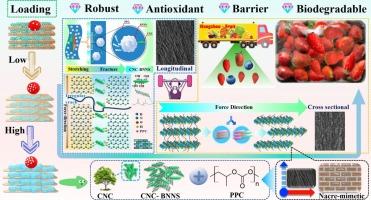Two-directions mechanical strength and high-barrier mechanisms of cellulose nanocrystal- based hybrids reinforced packaging with nacre-mimetic structure
IF 12.5
1区 化学
Q1 CHEMISTRY, APPLIED
引用次数: 0
Abstract
This work represents a new composite film with a nacre-mimetic structure through the alignment of hybrids comprising cellulose nanocrystals and ball-milled boron nitride (CNC-BNNS), within polypropylene carbonate (PPC) endowed with various properties. The impact of CNC-BNNS hybrids on mechanical strength mechanisms was evaluated under two-directional forces, marking the first such assessment. Using a solution casting approach, incorporating 5 % CNC-BNNS improved tensile strength by 67.6 % longitudinally and 4 % in the cross-sectional direction of the prepared PPC composite. Adding 5 %, CNC-BNNS increased the maximum degradation temperature by 12.1 °C and the glass transition temperature by 6.8 °C, as anticipated. Through synergies between CNC-BNNS and PPC, composite film with 15 % CNC-BNNS displayed enhanced barrier properties, notably reducing oxygen permeability (OP) and water vapor permeability (WVP) by 26.1 % and 90.9 %. Consequently, strawberries and blueberries packaged with these films saw extended shelf lives of up to 6 days. Furthermore, the degradation mechanisms of the composite in natural soil were investigated to assure the environmental issue, revealing a fast degradation rate of 44.5 % over 90 days. This study proposes a sustainable method for producing high-performance composite materials with antioxidant, liquid leakage resistance, and UV resistance, making them ideal for food packaging.

基于纤维素纳米晶的双向机械强度和高阻隔机理--仿珍珠质结构的混合加固包装
这项研究通过将纤维素纳米晶体和球磨氮化硼(CNC-BNNS)混合体排列在具有各种特性的聚碳酸酯(PPC)中,制成了一种具有仿珍珠结构的新型复合薄膜。首次评估了 CNC-BNNS 混合物在双向力作用下对机械强度机制的影响。采用溶液浇铸法,加入 5% 的 CNC-BNNS 可使制备的 PPC 复合材料的纵向拉伸强度提高 67.6%,横截面拉伸强度提高 4%。添加 5 % CNC-BNNS 后,最大降解温度提高了 12.1 °C,玻璃化转变温度提高了 6.8 °C,达到预期效果。通过 CNC-BNS 和 PPC 之间的协同作用,含有 15% CNC-BNS 的复合薄膜显示出更强的阻隔性能,尤其是氧气渗透率 (OP) 和水蒸气渗透率 (WVP) 分别降低了 26.1% 和 90.9%。因此,使用这些薄膜包装的草莓和蓝莓的保质期可延长至 6 天。此外,研究人员还调查了复合材料在天然土壤中的降解机制,以确保环境问题的解决,结果显示,90 天内的快速降解率为 44.5%。这项研究提出了一种生产高性能复合材料的可持续方法,这种材料具有抗氧化、抗液体渗漏和抗紫外线的性能,是食品包装的理想材料。
本文章由计算机程序翻译,如有差异,请以英文原文为准。
求助全文
约1分钟内获得全文
求助全文
来源期刊

Carbohydrate Polymers
化学-高分子科学
CiteScore
22.40
自引率
8.00%
发文量
1286
审稿时长
47 days
期刊介绍:
Carbohydrate Polymers stands as a prominent journal in the glycoscience field, dedicated to exploring and harnessing the potential of polysaccharides with applications spanning bioenergy, bioplastics, biomaterials, biorefining, chemistry, drug delivery, food, health, nanotechnology, packaging, paper, pharmaceuticals, medicine, oil recovery, textiles, tissue engineering, wood, and various aspects of glycoscience.
The journal emphasizes the central role of well-characterized carbohydrate polymers, highlighting their significance as the primary focus rather than a peripheral topic. Each paper must prominently feature at least one named carbohydrate polymer, evident in both citation and title, with a commitment to innovative research that advances scientific knowledge.
 求助内容:
求助内容: 应助结果提醒方式:
应助结果提醒方式:


